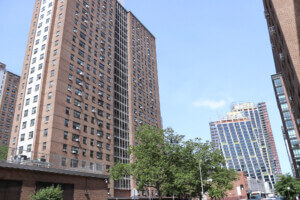Brooklyn-based interdisciplinary design studio Peterson Rich Office (PRO) and nonprofit civic organization the Regional Plan Association (RPA) have released a new 18-page report detailing design strategies and scalable solutions meant to boost the well-being of the roughly 600,000 New Yorkers living in deteriorating New York City Housing Authority (NYCHA)-owned and -operated developments. In total, NYCHA, the largest housing authority in the United States, acts as landlord for roughly 8 percent of all New Yorkers.
PRO was selected by the RPA to lead research and design work for the report last June as part of the organization’s inaugural J.M Kaplan Chairs for Urban Design fellowship, which expressly focuses on generating new and innovative design solutions that could be implemented at critically underfunded public housing campuses across all five boroughs. As envisioned in the initiative, funds to implement such strategies would come from a mix of (dwindling) federal, state, and local sources as well as untapped revenue streams such as air right sales and private infill development of unused space. Notably, the solutions conceived by PRO wouldn’t just chip away at cash-strapped NYCHA’s existing increasingly bleak, multi-billion-dollar repair backlog but would also help to finance quality of life-bolstering upgrades and modernization projects at the city’s over 300 public housing complexes, largely comprised of mid-rise brick buildings dating back to the 1950s and ’60s.
In other words, the aim isn’t just to fix and move on to the next urgent need, but to fix while also employing long-lasting, impactful solutions—“actionable ideas” as Miriam Peterson told AN last year—that make life at woefully neglected NYCHA properties safer, healthier, and more dignified for the current and future generations of public housing residents. Forty percent of all capital repair needs across NYCHA properties are needs that fall under the apartment category (aging, inefficient, and inoperable kitchens, bathrooms, etc.) followed by building-wide structural/architectural needs (leaking roofs, crumbling facades, etc.), systems (broken elevators and boilers, etc.) and sites/grounds (playgrounds, sidewalks, etc.)
“Rather than simply building new, we start by preserving NYCHA’s existing buildings and proposing scalable design solutions aimed at modernizing their facilities and campuses to better the living conditions of each resident,” said Peterson and Nathan Rich, her co-principal at PRO, in a press statement.
In its report, PRO uses the 721-unit Cooper Park Houses in East Williamsburg, Brooklyn, as a “typological example” to help better illustrate how harnessing and extending into unused spaces and underutilized landscapes while also diversifying the unit mix could vastly improve the development.
Among PRO’s key recommendations are building private balconies off each individual unit to better insulate existing buildings (a majority of NYCHA buildings are uninsulated) and free up interior space for “alternative mechanical systems” that would replace aging, inefficient ones; retooling largely forsaken existing ground floors to include space for support services, additional units, and light-filled lobbies that both more accessible and welcoming; installing split electric heat pump systems for improved efficiency and full individual resident control, and better integrating NCYCHA developments with their surrounding neighborhoods by further extending them to the sidewalk or street.
“Affordable housing in our hometown has been an enduring concern for The J.M. Kaplan Fund,” said Amy Freitag, executive director of the J.M. Kaplan Fund. “PRO’s vision for a more livable, sustainable NYCHA is a much-needed breath of fresh air, both literally and figuratively, for this essential housing infrastructure. We hope our partners in government give this inspired work serious and sustained attention.”
You can view the full Scalable Design Solutions for NYCHA report here.











